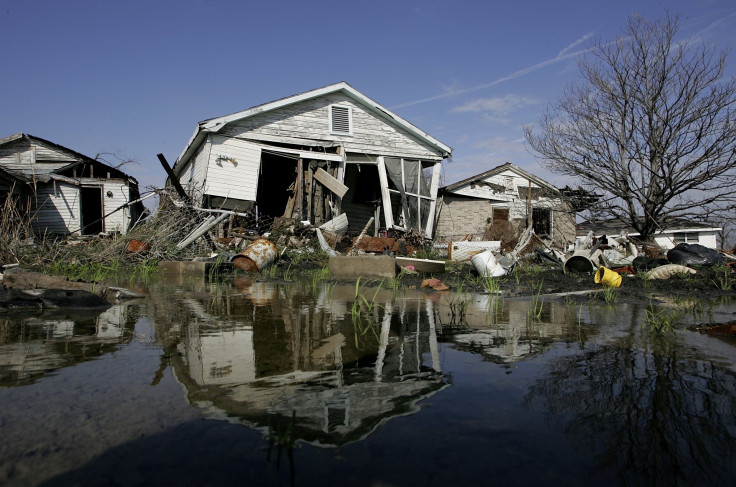Another Hurricane Like Katrina Would Cause Up To $200 Billion In Damages

KEY POINTS
- Katrina, a Category 5 hurricane that struck the coast in late August 2005, killed 1,833 people and caused $125 billion in damages
- As a result of Katrina, private insurance companies paid out some $41 billion on 1.7 million claims
- Katrina’s total insured loss amounted to more than $65 billion
As the Gulf Coast faces the onslaught of two tropical storms – Marco and Laura – a global insurer has warned that another hurricane like Katrina would cause up to $200 billion in damages.
Katrina, a Category 5 hurricane that struck the coast in late August 2005, killed 1,833 people and caused $125 billion in damages. The city of New Orleans was particularly devastated – the Crescent City was 80% flooded.
The storm also destroyed thousands of residential and commercial properties in Louisiana, Mississippi, Alabama, Florida and Georgia.
Zurich-based Swiss Reinsurance Co., also known as Swiss Re, claims another storm of Katrina’s magnitude would cause far more financial damage.
“Hurricane Katrina remains a watershed event for reinsurance as the most expensive natural catastrophe for the global insurance industry to date,” Swiss Re said. “Though New Orleans’ hurricane exposure and vulnerability have changed since Katrina, hurricane wind and storm surge continue to present a key risk to the Gulf Coast region, despite extensive mitigation efforts.”
Swiss Re noted that as a result of Katrina, private insurance companies paid out some $41 billion on 1.7 million claims for residential, commercial and automotive damage.
Insurers paid out another $8 billion for damages to offshore energy facilities in the Gulf of Mexico.
Including publicly insured losses to the Federal Emergency Management Agency’s National Flood Insurance Program, Katrina’s total insured loss amounted to more than $65 billion. Taking inflation into account, this figure would translate to almost $86 billion in 2020 dollars.
Swiss Re underlined that Katrina had a “profound” impact on the insurance industry, citing it as the “most expensive natural catastrophe for the global insurance industry to date.”
Hurricanes Katrina, Rita and Wilma – all of which occurred in 2005 -- collectively caused insured losses of $119 billion in 2020 dollars, more than 20% higher than the combined losses arising from hurricanes Harvey, Irma and Maria in 2017.
“Katrina was a sobering reminder that water can be a main driver of hurricane damage,” Swiss Re noted. “In the U.S., standard residential insurance policies exclude coverage for flood damage resulting from surface water, including storm surge caused by hurricanes… Litigation regarding Katrina claims focused on attribution of the damage to wind and/or water, an especially difficult distinction when sometimes only a property’s foundation remained. Such litigation forced the insurance industry to adopt better practices in policy wording, while also encouraging policyholders to better understand the scope of their coverage.”
Examining how “another Katrina” might impact New Orleans and environs now, Swiss Re pointed out that New Orleans’ population as of 2019 was only about 80% of what is was in 2000.
Also, after Katrina, New Orleans underwent a multi-billion-dollar upgrade in its flood protection system -- including the construction of surge barrier walls, flood walls, canal flood walls, pump stations and lakefront levees.
But despite these changes, the risk of storm damage remains high.
Swiss Re warned that climate will likely accelerate the incidence of flooding from such deadly storms, noting that in Grand Isle, Louisiana, a small barrier island south of New Orleans, the sea level is now rising by over one inch every two years.
If Hurricane Katrina were to hit the U.S. in 2020 with the same wind and storm surge as 2005, Swiss Re observed -- but with current exposure information and updated flood protection -- privately insured losses in the U.S. alone could still rise to $60 billion (excluding offshore losses in the Gulf of Mexico).
“The total economic toll from such an event could likely exceed $175 billion,” Swiss Re noted, despite New Orleans’ lower population and strengthened flood protection system.
“Economic losses from natural hazards like Katrina are expected to continue to increase,” the reinsurer added. “The expected impacts of climate change on tropical cyclones could also materialize in a pronounced way for a hurricane where most damage stems from flood like Hurricane Katrina.”
Thus, the total economic loss associated with such an event, Swiss Re calculated, “could easily reach” $200 billion.
The National Weather Service said early Monday afternoon that Marco weakened overnight to a tropical storm but warned that “gusty winds, dangerous and life-threatening storm surge and heavy rainfall with flooding are still expected today, especially later, along portions of the Gulf Coast."
Meanwhile, Laura will produce tropical storm conditions across the Florida Keys on Monday, before reaching the southeastern portion of the Gulf of Mexico early Tuesday.
© Copyright IBTimes 2025. All rights reserved.





















